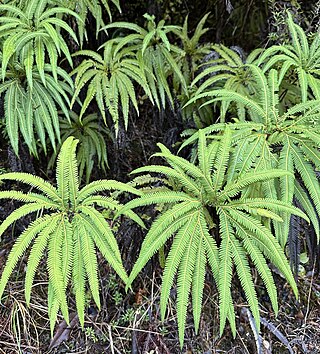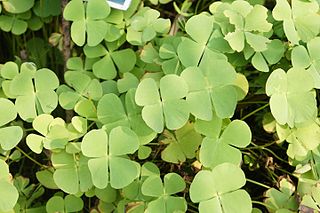
Aerides, known commonly as cat's-tail orchids and fox brush orchids, is a genus belonging to the orchid family. It is a group of tropical epiphyte orchids that grow mainly in the warm lowlands of tropical Asia from India to southern China to New Guinea. They are valued in horticulture for their racemes of showy, fragrant, colorful flowers.

Lycopodium is a genus of clubmosses, also known as ground pines or creeping cedars, in the family Lycopodiaceae. Two very different circumscriptions of the genus are in use. In the Pteridophyte Phylogeny Group classification of 2016, Lycopodium is one of nine genera in the subfamily Lycopodioideae, and has from nine to 15 species. In other classifications, the genus is equivalent to the whole of the subfamily, since it includes all of the other genera. More than 40 species are accepted.

Isoetes lacustris, the lake quillwort or Merlin's grass, is a boreal quillwort native on both sides of the northern Atlantic Ocean. Synonyms include Isoetes hieroglyphica.

Microsorum is a genus of ferns in the family Polypodiaceae, subfamily Microsoroideae, according to the Pteridophyte Phylogeny Group classification of 2016 (PPG I). The species are tropical. Like most ferns, they grow from rhizomes, rather than roots. The genus name is often misspelled "Microsorium" or "Microsoreum". It includes some species that are lithophytic rheophytes.

Rubus niveus is a species of Rubus. The native range of this scrambling shrub stretches from Afghanistan to central China, down to Java and Indo-China. It grows primarily in temperate regions.

Leptochilus pteropus is a species of aquatic or semi-aquatic fern, commonly known as 'Java fern'. It is predominantly known from Malaysia, Thailand, Northeastern India and parts of South China. It is a highly variable plant, with several different geographic varieties and physical forms that vary in leaf size, texture and shape. Found in its natural habitat growing attached to riparian roots and rocks, it can grow fully or partially submerged, provided its roots and rhizome remain wet. The plant will readily propagate asexually by producing small, adventitious plantlets from the leaf tips and margins of established, mature foliage. The small sprouts quickly develop roots of their own, and, if water currents facilitate it, may attach themselves to surrounding objects before the "mother" leaf expires. In the event that the mother leaf wilts or detaches prior to the plantlet establishing itself, the small fern will float on its own to a new location to start anew.

Phlebodium aureum is an epiphytic fern native to tropical and subtropical regions of the Americas.

Stenochlaena is a genus of ferns of the plant family Blechnaceae. Six species were formally accepted in an April 2013 scientific review of the genus, first written some years earlier and submitted in 2009. One additional species S. hainanensis awaits confirmation of its difference from S. palustris by means of differences in fertile material and/or its formal publication. One additional likely species grows naturally in Cameroon, Africa, recognised with the descriptive name Stenochlaena sp. 'Cameroon' but it awaits formal description.

Zealandia pustulata is a species of fern native to eastern Australia and New Zealand. It is commonly referred to as 'kangaroo fern' or 'kangaroo paw fern' as its native range includes Australia and the shape of its mature foliage tends to resemble the shape of a kangaroo's foot. It is also referred to as 'hound's tongue', and as kōwaowao and pāraharaha in the Māori language.

Aglaomorpha is a genus of ferns in the subfamily Drynarioideae of the family Polypodiaceae. The Pteridophyte Phylogeny Group classification of 2016 uses this genus name, while other sources use Drynaria to include Aglaomorpha. Species are commonly known as basket ferns. As circumscribed in PPG I, the genus contains around 50 species.

Sticherus cunninghamii, also known as umbrella fern, is a New Zealand endemic fern.

Diphasium scariosum, synonym Lycopodium scariosum, commonly known as spreading clubmoss or creeping club moss, is a species in the club moss family Lycopodiaceae. The genus Diphasium is accepted in the Pteridophyte Phylogeny Group classification of 2016, but not in other classifications which submerge the genus in Lycopodium.

Gloriosa superba is a species of flowering plant in the family Colchicaceae. Common names include flame lily, climbing lily, creeping lily, glory lily, gloriosa lily, tiger claw, and fire lily.

Acrosorus is a genus of ferns in the family Polypodiaceae, subfamily Grammitidoideae, according to the Pteridophyte Phylogeny Group classification of 2016 (PPG I). It is known from the Philippines, Malesia, Thailand, and the Pacific islands.

Marsilea minuta, or dwarf waterclover is a species of aquatic fern in the family Marsileaceae. It is not to be confused with Marsilea minutaE.Fourn. 1880, which is a synonym for Marsilea vestita. Other common names include gelid waterklawer, small water clover, airy pepperwort, and pepperwort, though the lattermost also applies to plants in the genus Lepidium. In French it is called marsilea à quatre feuilles and petite marsilée, the latter appearing to be a calque with the Latin botanical name. In Chinese it is 南国田字草, literally "southern field word grass," referencing the similarity of the leaflet shape to the Chinese character for "field." The Koch Rajbongshi people and Garo people call it shusni shak. It is called 'শুশনি শাক' in Bengali. In parts of India it can be called sunisanakka In Indonesian it is semanggi, but this name also applies to Marsilea crenata. In Japanese it is nangokudenjiso and in Thai it is phakwaen. In Malaysian it is tapak itik. In the Philippines it is kaya-kayapuan.

Dipteris conjugata is a species of fern in the family Dipteridaceae. It has a rhizome, and 2-3 tall stems with mid green or dark green fronds, which have several divisions to toothed lobes. It is grows in clearings, mountain ridges and in forest margins, from tropical and temperate Asia, northern Queensland in Australia and some islands in the Pacific Ocean. It has limited native medicinal uses.

Hypericum punctatum, the spotted St. John's wort, is a perennial herb native to North America. The yellow-flowered herb occurs throughout eastern North America into southern Canada. The process of microsporogenesis carried out by this plant is prone to errors in chromosomal segregation. It has a diploid number of 14 or 16. Insects are attracted to the plant's pollen and the hypericin in the plant's leaves is toxic to mammals.
Bosmania is a genus of ferns in the family Polypodiaceae, subfamily Microsoroideae, erected in 2019. As of February 2020, the genus was not accepted by some sources.

Dendroconche is a genus of ferns in the family Polypodiaceae, subfamily Microsoroideae, erected in 2019. As of February 2020, the genus was not accepted by some sources.
Dendroconche annabellae is a species of fern in the family Polypodiaceae, subfamily Microsoroideae. It is endemic to Papua New Guinea.






















